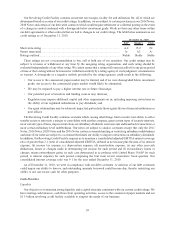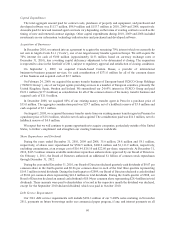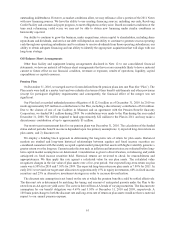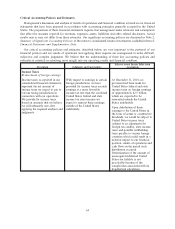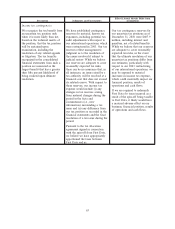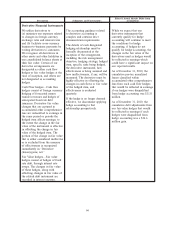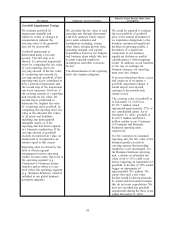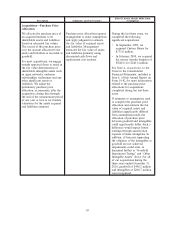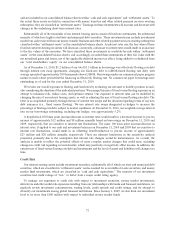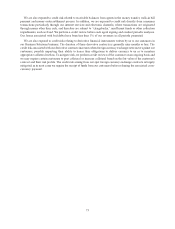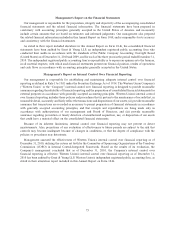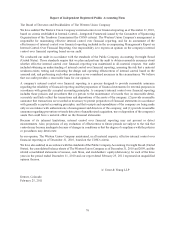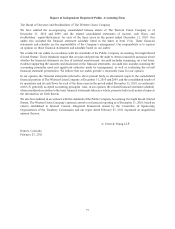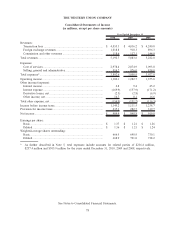Western Union 2010 Annual Report Download - page 70
Download and view the complete annual report
Please find page 70 of the 2010 Western Union annual report below. You can navigate through the pages in the report by either clicking on the pages listed below, or by using the keyword search tool below to find specific information within the annual report.
Description Judgments and Uncertainties
Effect if Actual Results Differ from
Assumptions
Goodwill Impairment Testing
We evaluate goodwill for
impairment annually and
whenever events or changes in
circumstances indicate the
carrying value of the goodwill
may not be recoverable.
Goodwill impairment is
determined using a two-step
process. The first step is to
identify if a potential impairment
exists by comparing the fair value
of each reporting unit to its
carrying amount. If the fair value
of a reporting unit exceeds its
carrying amount, goodwill of that
reporting unit is not considered to
have a potential impairment and
the second step of the impairment
test is not necessary. However, if
the carrying amount of a reporting
unit exceeds its fair value, the
second step is performed to
determine the implied fair value
of a reporting unit’s goodwill, by
comparing the reporting unit’s fair
value to the allocated fair values
of all assets and liabilities,
including any unrecognized
intangible assets, as if the
reporting unit had been acquired
in a business combination. If the
carrying amount of goodwill
exceeds its implied fair value, an
impairment is recognized in an
amount equal to that excess.
Reporting units are driven by the
level at which segment
management reviews operating
results. In some cases, that level is
the operating segment (e.g.,
Consumer-to-Consumer money
transfer) and in others it is one
level below the operating segment
(e.g., Business Solutions, which is
included in our global business
payments segment).
We calculate the fair value of each
reporting unit through discounted
cash flow analyses which require
us to make estimates and
assumptions including, among
other items, revenue growth rates,
operating margins, and capital
expenditures based on our budgets
and business plans which take into
account expected regulatory,
marketplace and other economic
factors.
The determination of the reporting
units also requires judgment.
We could be required to evaluate
the recoverability of goodwill
prior to the annual assessment if
we experience disruptions to the
business, unexpected significant
declines in operating results, a
divestiture of a significant
component of our business,
significant declines in market
capitalization or other triggering
events. In addition, as our business
or the way we manage our
business changes, our reporting
units may also change.
If an event described above occurs
and causes us to recognize a
goodwill impairment charge, it
would impact our reported
earnings in the periods such
charge occurs.
The carrying value of goodwill as
of December 31, 2010 was
$2,151.7 million which
represented approximately 27% of
our consolidated assets. As of
December 31, 2010, goodwill of
$1,619.9 million and $264.3
million resides in our Consumer-
to-Consumer and Business
Solutions reporting units,
respectively.
For the Consumer-to-Consumer
reporting unit, the fair value of the
business greatly exceeds its
carrying amount that providing
sensitivity is not meaningful. For
the Business Solutions reporting
unit, a decline in estimated fair
value of up to 15% could occur
before triggering an impairment of
goodwill. A decline of 30% would
trigger an impairment of
approximately $55 million. We
expect that such a fair value
decline would be driven primarily
by actual and forecasted revenues
that do not meet expectations. We
have not recorded any goodwill
impairments during the three years
ended December 31, 2010.
68



